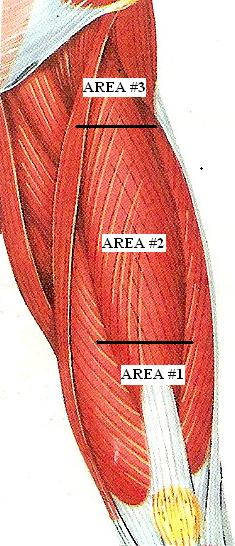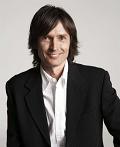What has compelled me to write this article is my love of doing and teaching massage. I LOVE IT! The whole world seems to be a brighter and happier place when I wake up knowing there are people out there ready to give me a chance to work on them.
On rare days when my calendar is free, I’m forced to give a shoulder rub to my wife, a tickle-hands massage to my hyperactive son, or a full-body massage to my slightly overweight, yet very athletic, dog. Needless to say, my position in the house is secure.
My goal is to create a community where massage therapists, athletic trainers, sports medicine directors and athletes are united through their commitment to an integrative approach to physical activities and sports training. It is my hope that sports massage will become one of the key elements in achieving maximum outcome with minimum damage to athletes.
How do we do that? (And I do mean “we”, you and me. I will need your help turning this concept into a reality.) We must work simply, step by step.
Forgive my bluntness, but I have heard many statements over the last 15 years of traveling across this country that I have a hard time agreeing with. Here are some:
“Sports massage does not contribute to athletes’ recovery.” (American Journal of Sports Medicine, 2004)
“You have to use elbows to give a really deep massage.”
“You should use more effleurage and/or compression (It feels good to a client while easy on you) instead of kneading (It will hurt your thumbs).”
“Four years in the massage profession are limited to just a few unless you find ways to preserve yourself.”
“There is very little true research being done in the sports massage field.”
“You do not really need to know the science of massage as long as you are happy with what you do.”
All of the above are simply not true. Additionally they do a disservice to our massage community by sending the wrong message to both practitioners and clients. Allow me to zoom in on what is important to the understanding of some of the main attributes of modern Sports Massage (SM).
In order to avoid any confusion, I will focus on the basic application of SM first, i.e., the one you would use on your fitness-oriented clients on any given day. (Pre-Event, Post-Event and Rehabilitative SM will be addressed in future articles.)
The major concept of SM is that it is an integrative part of athlete or fitness enthusiast training. This is a vastly important but frequently missed component among those who practice SM. SM, as an integrative part of training, means that the practitioner should know the entire training schedule of the athlete and incorporate different types of SM into the fabric of training. In such cases the practitioner should be in constant communication with the coach or personal trainer, know their plans and adjust his or her treatments according to the training schedule.
If we look at the list of services of any spa or gym we always find the listing of SM. I can guarantee that in the majority of cases this treatment is similar to regular massage, and in the best scenario one or two extra techniques are used. This is far from the science of SM.
I made this simple conclusion based on the fact that the listing of SM does not specify what exact type of SM is offered. Is the client going to the training session, or has he or she just come from or had three days off from training? In each of these cases the SM session should be different.
SM contains a lot of technical differences. However, I will concentrate on the couple lesser known ones. SM is used to decrease peripheral vascular resistance and a wide range of kneading techniques is an important tool to do that; the speed of massage strokes is significant. Furthermore, there are scientifically developed protocols of SM for the major types of sports as well as for personal training.
Let’s learn how to incorporate these concepts in your work:
Physical overload as a result of training often leads to accumulative muscular tension or increase in the resting muscle tone. This, in turn, contributes to an increase in the peripheral vascular resistance, which is the main opposition for left cardiac work during heart contraction. In such cases, the cardiovascular system is not only overloaded during vigorous exercise, but also has to work harder even at night, especially between 1 and 4 a.m. This is the part of the day when the muscle pump doesn’t work and the peripheral resistance rises. It finally leads to the development of hypertension with a one-way ticket to a heart attack.
One of the tools used to decrease the peripheral resistance and normalize resting muscle tone is a combination of massage in the inhibitory regime and application of kneading techniques. The inhibitory regime of massage therapy is a repetitive application of the one or two strokes with moderate pressure with the same speed and direction, on the same area. All this while your mental focus and intent is to reduce peripheral vascular resistance.
The SM practitioner should combine two or three techniques – for example, one stroke of superficial effleurage, one stroke or two strokes of kneading. The practitioner should re-apply this protocol with the same pressure and in the direction of lymph drainage while working on the segment.
After application of massage in the inhibitory regime the kneading should be applied. Kneading is the main massage stroke when it comes to decrease of peripheral vascular resistance. In general, you should spend at least 50% of your SM session on various kneading techniques. Many massage therapists avoid these valuable massage techniques as they believe it puts too much stress on their fingers, especially their thumbs.
Here is the secret to saving your thumbs: Learn MORE kneading techniques, and their application using correct body mechanics.
I absolutely agree with Dr. V. Kramarenko, MD who wrote in 1953: “One can estimate the level of a massage therapists expertise by testing the kneading technique only.”
Kneading should be approached as “passive exercises for the skeletal muscles” since it has both stimulating and inhibiting effects on the muscle tone. Do not apply any excessive pressure during your kneading. Use as little lubricant as possible. As a rule, you should master at least five or six different kneading techniques while becoming as familiar with the rest of them (12 in total).
The necessity for the variety of kneading techniques used by sports therapists is based on the fact that different parts of the body, as well as different clients, because of body type, require application of special kneading techniques. If the practitioner is restrained with the application of one or two of these kneading techniques he or she will become exhausted very quickly. This is the reason why kneading is wrongly considered to be the most energy consuming massage technique.
Without knowledge based on the vast body of scientific research, a therapist is merely working mechanically, potentially doing more harm than good for the athlete. This understanding will allow you to better assess the effectiveness of your treatment and better adjust for future sessions with your client.
Let me give you a simple example. It is amazing how, by using kneading techniques with the same pressure and duration, but simply changing the order in which origin, belly, and insertion of a muscle massage you get a completely opposite outcome to your treatment.
By using the two different kneading protocols the practitioner may inhibit or stimulate the muscle tone.
In cases when you need to relax muscle and to reduce muscle tone (for example during the rehabilitation SM):
FIRST: visually split the massaged muscle into three parts (see Fig. 1)
SECOND: apply kneading to the insertion part of that muscle (area #1) to activate Golgi tendon organ receptors.
THIRD: apply kneading to the belly of that muscle (area #2) to activate muscle spindle receptors.
FOURTH: apply kneading to the origin part of that muscle (area #3) to activate Golgi tendon organ receptors.

In cases when you need to stimulate a muscle and to increase muscle tone (for example SM before training):
FIRST: visually split the massaged muscle into three parts (see Fig. 1)
SECOND: apply kneading to its insertion (area #1) to activate Golgi tendon organ receptors.
THIRD: apply kneading to its origin (area #3) to activate Golgi tendon organ receptors.
FOURTH: apply kneading to its belly (area #2) to activate muscle spindle receptors.
An equally important part of correct kneading protocol is to understand theconcept of lifting of muscle fibers during the application of kneading techniques and the concept of stretching (without lifting) muscle fibers.
The kneading techniques with the lifting component are used mostly while working on the muscle’s origin and insertion while the kneading techniques with the stretching component mainly are used to address the muscle’s belly. This will allow you to target specifically Golgi tendon organ receptors in the first case or muscle spindle receptors in the latter case. Alternating activation of these receptors inhibits or stimulates the muscle tone within the same application!.
The another component of SM is to develop a much faster speed of strokes applied in the direction of lymph and venous blood flow. In order to master it and make it effortless, you have to focus on relaxation in between and duringstrokes and correct body mechanics. Development of that skill will lead to efficiency in movements. It will let you to stay relaxed, and to find a proper rhythm for massage strokes, while having fun playing with different speeds.
The proper rhythm is a key to your efficient and effective work as a massage therapist. The slow, relaxing speed of the strokes in SM is used only if the athlete has at least one day break in training after the treatment.
It is my sincere hope that you, my respected colleagues, will add to your already strong belief in the power of massage a solid knowledge of its undeniable benefits for athletes as well as fitness enthusiasts. Sports Massage works beautifully! Know it! Use it! Enjoy it!

Oleg Bouimer, LMT, graduated from State Institute of Physical Education in Ukraine in 1985. Currently he has an extensive private practice in Los Angeles. Among his clients are celebrities, famous politicians and sports stars. The NBA, NHL and NFL widely recognize Oleg and the system of Russian Sports Massage. He teaches nationwide and has founded a Medical and Sports Massage Club in Los Angeles. Oleg is author of many articles in American and European professional journals. He can be reached by e-mail: olegnancy@msn.com
Category: Sport Massage
